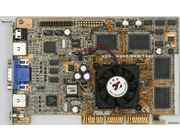An improvement over the 3D Rage II: a new triangle setup engine, perspective correction improvements, fog support and transparency implementations, specular lightning support and better DVD (MPEG2) playback. The 3D Rage Pro can take advantage of AGP.
This card is based on nVidia's first GeForce-GPU (codename NV10). The GeForce 256 is the successor of the RIVA TNT2 and has some new features including Hardware Transform and Lightning (T&L). It's a fully DirectX 7.0 complaint 3D-card.
In general we can say that the GeForce 256 was impressive at it's time but had a low pixel/texel fill-rate. Games that were able to use the T&L engine weren't around yet so the GeForce 256 wasn't at it's full potential.
Take a look at this little timeline to get an insight of what was going on back in 1999:
31 August 1999
Press-release of the nVidia GeForce 256, cards weren't for sale much at this time. Tweak3D posts a preview of the GeForce 256.
1 September 1999
More pre/re-views are appearing. Some say that the 120MHz core-clock is low. They conclude that the GeForce 256 is a chip with 23 million transistors (at 0.22 micron) and thus difficult to clock higher. It also turns out that the GeForce 256 has a fill-rate of 480 million pixels per second. That's double the fill-rate of the original RIVA TNT2. The GeForce 256 is able to do this through it's four-pixel pipeline rendering engine. 4 pixel pipelines * clock frequency (120*4 = 480).
3 September 1999
People are wondering what the facts are about the pixel and texel filtrate of the GeForce 256. It turns out that both texel and pixel filtrate are 480 million per second. They conclude that it's not much and competitors (S3 and 3dfx) are able to keep up with the GeForce 256 unless developers, in future games, start using high polygon count models. Of course we have to take in account that both pixel and texel filtrates aren't suitable for performance comparison.
4 September 1999
3dfx claims that the GeForce256 will be slower than 3dfx's upcoming (VSA-100; Voodoo5) graphics card.
20 September 1999
It turns out that the GeForce 256 still isn't really available.
11 October 1999
Many reviews pop-up due the ending of the NDA.
10 January 2000
This card. > Read more

